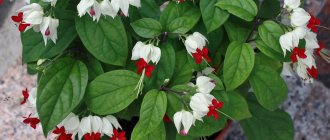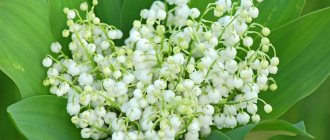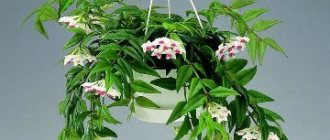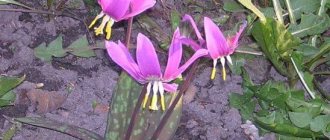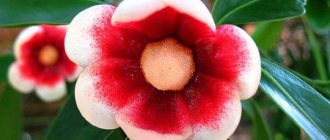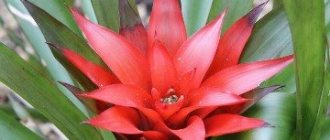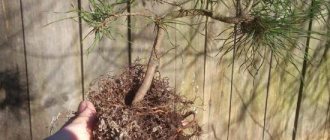Among those capable of accumulating water in the trunk of plants, pachira aquatic has always occupied a special, honorable place. And it’s not just that the plant is called a bottle tree (deservedly). This beauty, unlike her competitors, can rather boast of her classic appearance. Large pachira leaves with a strict silhouette and an unusual, but revealing its true beauty only up close, trunk and tree-like silhouette made this plant a legend. But the main advantage of this non-standard caudex is its rather large size. Able to compete with trees and shrubs, aquatic pachira tolerates indoor conditions well and requires, although specific, but very simple care.
Pachira aquatica. © MP3SILVER
Caring for pachira at home. Briefly
Pakhira at home is not particularly difficult to care for. It is enough to maintain the following conditions of detention:
| Temperature | In autumn and winter not lower than 16 degrees Celsius, in summer – not higher than 23 degrees |
| Air humidity | Avoid dry air, maintain humidity at 60 percent |
| Lighting | Indirect sunlight, preferably placed in the southern, southwestern part of the room, while avoiding overheating. |
| Watering | In hot weather - 2-3 times a week with warm water. In winter - rare watering in order to prevent the surface layer of soil from drying out. |
| Priming | A mixture of turf and leaf soil with the addition of sand in equal proportions is used. It is important to ensure good drainage. |
| Feeding and fertilizer | From early spring to the end of autumn, it is advisable to feed the tree with complex mineral fertilizer every three weeks. |
| Transfer | It is carried out annually for a young plant, for an old one - every 2 years. |
| Reproduction of pachira | It is carried out by seed in the spring, or by cuttings closer to autumn. |
| Features of cultivation | It is worth paying special attention to the degree of soil moisture, while avoiding excess moisture in the plant. In addition, it is important to control the degree of illumination of the flower. Pachira, which is in the shadows, fades and slows down in development. |
Features of growing Pachira
The bottle tree grows rather slowly, but under favorable conditions it can grow up to 20 meters in the wild. At home, Pakhira grows up to three meters in height and one and a half meters in crown diameter. The tree trunk is bottle-shaped and widens towards the bottom. There is a cavity between the bark and the wood in which the tree stores water. Young trees usually grow into one trunk. Only when they reach a height of two meters does branching begin. The leaves of the plant are leathery and bright green. They are palmately complex in shape, with long petioles. As we already wrote, they are very similar to chestnut leaves.
Under natural conditions, Pachira is a tall tree with a voluminous crown.
Pachira blooms very rarely indoors. You can only see it blooming in the wild or in greenhouses. Many narrow and long, up to 15 cm, fragrant flowers of white or yellowish color are collected in a large paniculate inflorescence, about 35 cm in length. After flowering, fruits are formed, elongated-rounded, olive-colored, from 10 to 25 cm in length.
Pachira is a non-poisonous plant. It can safely be grown in rooms where there are children and pets. Pachira seeds are edible and can be eaten raw or roasted.
The plant looks especially exotic and beautiful when its stems are braided at a young age or the tree is grown as a bonsai. You can also grow Pachira as a single tree, but then you should know that the formation of lateral shoots and tillering will occur several years later, when the plant grows to the ceiling. Therefore, at a young age, several specimens are planted in one pot at once, and the stems are intertwined with each other in a kind of braids. Flower shops most often sell just such specimens of Pachira - with several intertwined stems. The process of creating such a masterpiece is quite labor-intensive and lengthy, which is why the cost of such plants is quite high.
Caring for pachira at home. Details
The pachira flower will add a touch of beauty and comfort to your home. Care at home does not present any particular difficulties, but still some nuances are worth considering in more detail.
Pachira flowering
Pachira flowers are very beautiful, they have a subtle vanilla aroma, but they can only be observed in natural conditions or in a greenhouse.
As a rule, active flowering occurs from the beginning of summer to the end of autumn. The inflorescences are a cluster of many long stamens of bright yellow or red color, surrounded by pinkish, greenish or cream petals. The diameter of the flowers is 10-15 centimeters, 30-35 cm long. Later, fruits are formed from the inflorescences, which, after ripening, split into two halves, revealing up to 20 round-shaped “nuts” inside.
Temperature
In hot weather, pachira should be protected from overheating and prolonged exposure to direct sunlight. The maximum permissible room temperature is 23-25 degrees. In winter, drafts should not be allowed, nor should the temperature drop below 16 degrees.
In addition, the plant should not be located near heating devices and radiators.
Spraying
Due to the fact that pachira is a tropical plant, it is very important to maintain the natural level of humidity for the flower. If the air in the room is too dry, you can correct the situation by regularly spraying the leaves. When spraying, moisture should not come into contact with the source of crown growth to avoid rotting. Spray with settled water at room temperature.
Lighting
In order to preserve the decorative appearance of pachira for as long as possible, it is important to monitor the level of illumination of the plant. With a lack of sunlight, the flower stems become elongated and the crown loses its neat round shape.
But at the same time, prolonged exposure to the sun has a detrimental effect on the leaves; “burn” spots may appear, so the best option would be to provide the plant with diffused soft light, as well as some shading of the flower when sunlight is too intense.
Watering
During the hot season, home pachira needs regular watering.
At the same time, it is necessary to monitor the degree of soil moisture. If the soil surface is wet, watering should be postponed until the top layer dries out a little. In winter, watering is carried out rarely and only when the soil of the plant has dried to about 3-4 cm from the surface. Otherwise, the plant will begin to rot. Watering should be done with settled or rain water, without using watering using a tray.
Pachira pot
The pot, in this case, is selected depending on the size of the flower and its root system. Thus, a young plant with a minimum number of roots does not require deep containers; a small but wide container with a diameter of at least 29 cm is sufficient.
A pot that is too small will inhibit the growth of the pachira. And if it is too deep, part of the soil will not be used by the plant, which can lead to a change in the properties of the soil and its further acidification.
Soil for pachira
To successfully grow pachira, you need “breathing” soil that is not too rich in nutrients. A mixture of turf and leaf soil, mixed with sand and brick chips in equal proportions, is suitable. Including favorable for the growth of pachira and universal soil for palm trees and dracaenas. The main condition is that the soil must become permeable, with good drainage.
Feeding and fertilizer
Feeding pachira is best done in the spring and summer months, with a frequency of every two weeks. As fertilizers, you can use either specialized mineral additives for non-flowering ornamental deciduous plants, or feed the tree by spraying the leaves with anti-stress drugs.
In the first case, 50 percent of the recommended concentration of the additive for decorative deciduous varieties should be used. When spraying leaves, it is better to use the dosage specified by the manufacturers.
It is not recommended to fertilize pachira in autumn and winter.
Pachira transplant
A pachira flower at home will decorate any home with its appearance for a long time if it is replanted in time and thereby prolongs the period of active growth. It is better to replant a young flower every year in the spring. Perennial specimens are replanted every two years, also in the spring months. In both cases, replanting is carried out with a complete replacement of the soil and the whole process is as follows:
- the plant is removed, and the root system is slightly straightened;
- the roots are placed in a container with water for no more than 15 minutes;
- the remaining soil is removed from the roots, and dead, damaged and rotting areas are also removed;
- if desired, shorten the remaining healthy roots;
- fill the pot with the mixture for replanting in the form of a slide;
- We place the pachira root system on top, evenly distributing the shoots throughout the entire volume of the pot;
- fill the remaining volume of the flower container.
How to trim pachira
Pakhira at home does not require obligatory circumcision. This is only necessary if the plant has lost its decorative appearance. In this case, formative pruning is carried out in early spring. At the cut points, the flower branches and the crown becomes more lush and spherical. Simply dead, dried leaves and stems can be removed at any time.
Conditions required for pachira aquaticus
One of the main advantages of pachira aquatic is its unpretentiousness. It does not need a cool winter, but can put up with it, does not make any special demands on other growing conditions and, with sufficient lighting, causes practically no problems. This plant is suitable even for novice flower growers and those who do not have enough time for meticulous care: pachira is rarely watered, which can significantly relieve the schedule of caring for its collections.
Of course, it will not join the list of the best indoor Spartans, but it is still a very friendly plant. The high price of pachira is associated with the difficulties of its cultivation and formation, many years of growing until it reaches an attractive shape.
Lighting for pachira aquatic
In fact, the water pakhir makes the only strict requirements for lighting. This plant requires either a sunny location or indirect bright light. Direct midday rays leave burns on the leaves, but morning and evening rays are not scary for pachirams. Pachira is not grown even in light partial shade.
The light-loving beauty can tolerate some reduction in light intensity in winter, but if it is possible to compensate for it, this will only have a positive effect on the attractiveness of the crown. You need to change the lighting in winter gradually, spreading its movement to a new place over several stages.
Finding a place for a pakhira is not entirely easy. Only young plants fit on the windowsill without any problems, but adults need to be moved into the interior, and there it is difficult to recreate bright lighting. Eastern and western window sills are considered the ideal place in terms of lighting intensity.
Comfortable temperature conditions
The bottle tree feels good in any living room. Normal room temperatures from 18 to 23 degrees are suitable for it, but the plant will be able to adapt to a hotter environment, provided air humidity increases, and to colder temperatures, if the readings do not fall below 12 degrees Celsius. Changing conditions in winter is not necessary for this plant, but if there is a natural decrease in air temperature, the pachira will not suffer. In the heat of winter, if there are no measures to compensate for the reduction in light, the pachira may begin to stretch.
Resistant to temperature changes, pachira thrives outdoors in summer. But you can display it not in the garden, but on a terrace or balcony protected from wind and rain.
Air humidity for pachira
The air humidity for pachira should be high, if possible. It does not require constant measures and a tropical environment, but if you can increase the indicators to 60% or more, then the plant will respond to such care with more active growth.
Reproduction of pachira
Reproduction of this plant is possible in two ways - vegetative and seed.
Propagation of pachira by cuttings
The vegetative method of propagating pachira is propagation by cuttings. For this purpose, a cutting up to 10 cm in size is taken, having a formed structure with two leaf nodes.
Rooting is carried out as follows:
- the lower edges of the cuttings are treated with a root formation activator
- a soil mixture is compiled from equal parts of sifted sand, charcoal, leaf humus and half a part of sphagnum
- the resulting mixture is sterilized
- cuttings are planted in containers or plastic cups with a mandatory hole for drainage
- The lower parts of the cuttings are immersed in the soil by 30 mm, followed by watering.
The rooting period is about 3 weeks. Under favorable conditions, namely: diffused light, temperature 20-22 degrees, humidity level about 80 percent, this process can be carried out in water.
To do this, the treated cuttings are placed in a container with water and after roots appear, they are transplanted into the soil mixture. This is a rather stressful moment for a young pachira, because during this period the flower needs to be provided with optimal conditions for germination.
Growing pachira from seeds
Propagation by seeds is carried out in the following way: pre-soaked and squeezed sphagnum is placed in a sealed bag in a layer of 2-3 cm. We place a flower seed on top, which is covered with another layer of moss. Since the germination rate of pachira seeds is approximately 30-40 percent, it is worth preparing 4-5 such packets in order to guarantee the desired result.
Conditions for germination of pachira seeds:
- air temperature 25 degrees
- diffuse light
- wet and not wet sphagnum moss
- indoor humidity – 80 percent
- ventilation several times a day.
Sprouted specimens along with moss are planted in the soil and during the first week of germination the plant is maintained at a high level of air humidity. After a month, if there is active development, you can carry out the first feeding of the pachira.
Planting and propagation
To propagate pachira, it is best and most effective to choose the cutting method. The most favorable time for this procedure is the end of the summer season. The choice of cuttings must be approached with the utmost seriousness. To do this, it is important to find a pachira cutting so that it has at least one bud and leaf.
It is necessary to carefully and most importantly, using a sharp knife, cut off this part of the flower, while capturing a small piece of the trunk. It is advisable to sprinkle activated carbon powder at the cut site and place the cutting in a mixture of peat, sand and expanded clay.
The future Chinese tree at the cutting stage is covered with a special cap. The growth of the cuttings must be accompanied by ventilation and monitoring the condition of the soil. It shouldn't dry out. The cutting begins to take root after 14 days. The next step is to plant it in a pot.
Reproduction is also possible by seed. This will take longer, but is not particularly difficult. The only important thing in this case is the presence of fresh seeds. A mixture of expanded clay, peat and sand is also perfect for tree seeds.
to plant pachira seeds deep into the ground. It is enough to just sprinkle them with a little soil. Afterwards the seeds are covered with glass. At this time, regular ventilation and moistening of the soil is very important for them. After 30 days, the first shoots appear.
Diseases and pests
- Pachira leaves turn yellow due to severe lack of nutrients and microelements.
- Leaves fall off when the plant is too close to heating systems or heating devices.
- Pachira leaves droop and wither due to acute lack of moisture.
- Pachira leaves fade and wither in insufficient light. It is best to provide the plant with access to soft morning or evening sunlight. And on the contrary, with excess lighting, light spots appear on the leaves of the pachira, which indicates that the plant has sunburn. In cool seasons, at temperatures below 15, the leaves become soft. The flower reacts very quickly to critically low temperatures and frequent drafts - the leaves of the pachira curl. The most alarming sign that the plant is dying is the fact when the leaves of the pachira turn black and fall off.
- The pakhira stretches out only in one case - when it is constantly in the shade and lacks direct rays of the sun. Other plant diseases are associated with the appearance of pests, such as thrips, scale insects, aphids, and spider mites. But, as a rule, this is rare and with proper care the plant does not suffer from parasites.
Possible difficulties during cultivation
Soft trunk. If you encounter such a problem, then your plant’s root system is rotting. This may be due to excessive watering or stagnation of water in the pan. To try to save Pachira you need to dig it up, cut off the affected parts and treat the cut areas with charcoal wood chips.
Brown leaf tips. This may be due to low humidity or drafts. Water and mist your plant frequently, and move it away from drafts.
Rolling leaves. This problem is associated with temperature changes. Make sure everything is at the correct temperature.
Thin, elongated stem. This happens due to lack of light, move Pachira to a more illuminated place.
Spots on leaves. The most likely cause of this problem is sunburn. Move the plant to another location or darken it.
Falling leaves. Most often this happens due to the pot being too large. Try transplanting Pachira into a smaller vessel.
Yellow and dry leaves. If Pachira's leaves turn yellow, then there are not enough minerals in the soil. Feed the plant or change its soil.
Types of pachira domestica with photos and names
Pachira aquatica, aquatic
Belongs to the mallow family, has smooth green leaves on oblong petioles and inflorescences 30 cm long, reminiscent of a panicle. The flower gives off a vanilla aroma and later a greenish fruit is formed from the ovary, inside of which there are up to 20 edible nuts covered with a dense peel. These seeds, as well as the leaves and bark of the tree, are used in cooking and in the treatment of certain diseases.
Round-leaved pachyra
The rarest type of plant. A distinctive feature is the unusually round structure of the leaves. The shoots of this flower in the wild spread along the ground, so at home it can be grown in hanging pots and flowerpots.
Silver pachira
It differs from the most popular aquatic pachira only in the original pattern on the leaves in the form of many silver stripes-threads.
Pachira aquaticum - tree-like caudex with elegant simplicity of leaves
Pachira aquatica does not at all look like an exotic plant and, unlike its caudex colleagues, at first glance it does not give the impression of an unprecedented exotic. In spirit and character, it is more akin to classic indoor woody plants; it gives the impression of a traditional and even relict plant. Strict, neat, with simple but elegant forms, the pakhira is easily misleading. Despite such a discreet appearance, it requires the same care as any other caudex plant.
The pachira came to us from the tropical forests of South America, where it can be found in swampy areas. In its homeland it is also known as the Guiana or Malabar chestnut, and in the West as the Chinese and money tree. In our country, Pachira aquaticus is most often called the bottle tree, although it shares this name with several other caudex crops.
The water pachira (Pachira aquatica) captivates with its tree-like silhouette and structure. From a distance, it is difficult to guess the unusualness of the pachira: it just seems like a classic, strict and even somewhat prim tree. And only from a close distance can you appreciate all the advantages of this beauty. Most often, pachira plants on sale are represented by specimens with artificially intertwined trunks, which seem like a bizarre work of art.
But pachira trees with a simple trunk are also very beautiful (especially since with age they will begin to bush and produce side shoots). Weaving the trunks of several different young plants into a kind of braid is very impressive, but it also has its drawbacks: over time, sooner or later, some of the plants intertwined with each other die and die, and only the strongest survive. But this happens slowly and for many years you can admire the complex ligature of the stems.
The height of the trunks increases over time: in young plants they are practically not visible, but the “leg” gradually lengthens and rises. The height of pachira aquatic in indoor culture is limited to 1-1.5 m. The trunk is thickened downwards, it stores water between the bark and wood. Branches with luxurious leaves only decorate the original trunks of the plant.
Even the foliage of the aquatic pachira is deceptive. From a distance, it seems that the plant produces classic large oval-lanceolate leaves with an impeccable silhouette, but everything is not so simple. In fact, the ideal dark leaves are just fractions of five-fingered complex leaves spread out like a palm. The dark, rich color favorably emphasizes the classic beauty of the greenery of this plant. The palm-shaped leaves of Pachira aquaticus seem both massive and graceful at the same time. And even if there are not so many of them, they create a full-fledged crown.
Pachira aquatica
Use of pachira aquatica
In place of the pachira flower, elongated large green berries are formed. Some sources call their pulp inedible. Others claim that they can be eaten. Each fruit contains up to 25 nut seeds. The seeds can be consumed raw. They can be fried or boiled before eating. The seeds are also ground into flour, from which bread is baked. A delicious drink, like hot chocolate, is prepared from the same powder. Leaves and flowers are also eaten.
Pachira plants are very popular. They are used to create bonsai. They are believed to bring good luck, health and prosperity to the home. They should increase with each new leaf. The plant has the fame of the money tree. It is believed to bring good luck and prosperity.
How to deal with pests - table
| Pests | Damage | Control measures |
| Spider mites | Small purple insects. As a result of their attack, the leaves turn yellow and become covered with cobwebs. |
|
| Shields | When a scale insect attaches itself to a leaf, a yellow spot appears there, gradually increasing in size. The leaf turns yellow, curls and falls off. | The insect is covered with a “shield”, so spraying has almost no results. You need to collect pests manually: moisten a napkin in a solution of Aktara or Karbofos and carefully wipe all the leaves. |
| Aphid | Small insects (look like white droplets). They feed on the juice of leaves. Leave sticky marks. |
|
| Thrips | Small insects with a narrow, elongated body and wings. They leave traces - small dark dots. They destroy leaves and are carriers of viruses and diseases. |
|
Pachira leaves fall off and turn yellow. What should I do?
- If you have not replanted the plant after purchasing it, soon the leaves of the pachira will begin to turn yellow and fall off due to the lack of nutrients in the soil and acidification of the soil. An urgent transplant with soil replacement is needed. In order for the plant to quickly take root, it can be watered with a root solution.
- Dropping of the lower old leaves is normal, especially when the plant enters its dormant period in the fall.
- Very dry air can also cause leaves to turn yellow and dry out; you need to place a humidifier nearby or keep the plant on a tray with damp expanded clay.
- Drying out the roots also causes leaves to fall off. The solution is to establish the correct watering regime. All yellowed leaves should be cut off to give the plant a chance to recover; it is advisable to fertilize it to maintain the flower in a stressful situation.
- During the cold period, the money tree may suffer from drafts: if the window is open, do not also open the door. Draft and hypothermia can also cause leaves to fall.
- Add epin to the water for spraying pachira to help the plant recover from yellowing leaves, remembering to identify and eliminate the cause.
Pruning pachira and forming a braided trunk
To form a beautiful lush crown, it is necessary to trim the crown. This is done in the spring, when the branches have grown sufficiently and become stronger. New shoots will appear at the cut sites, making it possible to create the desired shape.
When root shoots appear, they must be removed in order to preserve the formed shape of the trunk and prevent the plant from weakening in the future, when it will be difficult to cut off grown side shoots.
How to braid a pachira
Several plants intertwined with each other look very impressive. To obtain such beauty, it is necessary to plant 3-4 cuttings of equal height in one container. Intertwine them with a braid or wrap them in a spiral, tie the top with twine so that the shoots do not diverge. It is important not to overtighten: if the trunk is damaged, sap flow will be disrupted and the plants will die.
Over time, the stems will take on the desired shape and continue to grow. Trim the leaves as they grow and continue curling the trunks, but do this before the stems become woody. If you remove the bark where the trunks touch, they will grow together and look even more harmonious.
| Conditions | Recommendations |
| Light | Lighting for pachira needs to be bright, but diffused; the tree can easily withstand intense sunlight, but for a short time, in the future, burns may occur on the leaves. A shady place is also not suitable for pachira; it stops growing, the stems become thinner, and the foliage loses its color. An east-facing window is best suited for placement. In autumn and winter, additional illumination with fluorescent lamps is required. |
| Temperature | Pakhira loves warmth. The optimal temperature for it will be from +22 to +25 ºС; in the autumn-winter period, in order to arrange a period of relative rest, the temperature can be reduced to approximately +18 ºС. The plant does not tolerate cold and drafts; at +15 ºС its roots and caudex begin to rot. |
| Air humidity | Pachira is moisture-loving; for excellent vegetation it needs frequent spraying. Water should be sprayed around the tree, being careful not to get moisture on the trunk. The plant can also tolerate a little dry air (usual indoors), but in humid conditions the pachira feels much more comfortable. |
Possible problems
- Rotting of the plant - with excessive watering or if water often gets on the trunk.
- The leaves curl and become brownish at the edges - low air temperature or sudden changes in night and day temperatures.
- Spots on foliage may appear due to direct sunlight.
- The leaves become brownish at the edges - poor watering, dry air or drafts.
- Shoots stretch out due to lack of light.
Plant care
Some gardeners believe that pachira requires special care. Others classify it as a plant that does not require special care. Pachira aquatica is in no hurry to grow; it grows only a few centimeters per year. It begins to branch only after the tree grows large. Before this, it does not have side shoots.
It is recommended to place a young pachira on a window, but not on the south or north. It is better not to install it on the northern pachira, because the lack of light causes the trunk to stretch out and become ugly.
You can install the pachira on a south window for a while, but you need to shade it from the direct rays of the sun at noon. If this is not done, unsightly pale burn spots may form on the leaves.
It is easy to maintain the temperature regime for maintaining the plant in any apartment. It should not be below 16 degrees in winter, and above 25 degrees in summer. Do not install the pachira near radiators or other heating devices. But most of all she is afraid of drafts.
Humidity is not of great importance for pachira. It can grow indoors with both dry and fairly humid air. It can be sprayed with warm water a couple of times a month. The sprayer stream should be directed at the leaves, trying not to hit the trunk. Excessive moisture can lead to rotting.
Pakhira after purchase
After purchase, the plant must undergo an adaptation period in the indoor conditions of your apartment within two weeks. It is advisable to keep the tree in quarantine: away from other plants. And only after making sure that there are no pests on it can it be moved to a permanent place.
When the quarantine period is over, it is better to replant the flower immediately: transport soil is not the best environment for permanent maintenance of pachira. Water the plant, let the soil become damp and remove the plant from the pot. Select a tall, stable pot a little wider than the existing one and replant the tree, trying to replace the old soil with new soil (palm substrate is suitable). After replanting, water the plant moderately with root solution to restore damaged roots.
Features of care
Proper watering
The plant should be watered regularly in the summer and in an amount sufficient to completely saturate the earthen clod. Don't forget to drain excess water from the pan. Before the next moistening, the soil should dry out slightly.
In winter, watering is reduced, but the earthen clod does not dry out for a long time. Water is used that is soft, settled and warm.
When moistening the soil, try not to get it on the trunk, so as not to provoke its rotting.
Water and spray the pachira carefully, being careful not to wet the trunk
Watering can also be done in the following way: immerse the pot with the plant 2/3 of its volume in a basin of water. Leave for several hours. But this method should not be used if the room temperature is below 20 or the plant has just undergone transplantation.
Top dressing
Like any plant, pachira needs feeding. It is best to use fertilizers designed for palm trees. Fertilizers for decorative deciduous plants are also suitable. They are applied only to moist soil, once every 3-4 weeks.
They begin to fertilize in April, with the onset of the growing season, and finish in September. To avoid burning the root system, the concentration of fertilizers is slightly reduced.
Nuances of pruning
Unlike the trunk, the crown of the pachira grows very quickly and needs pruning. It is carried out in early spring or summer. Weak, elongated or dry shoots are removed. Branches that are too long are shortened. The procedure helps to form a lush and beautiful crown of the plant. The most suitable pachira is a spherical or oval shape.
Pruning pachira helps to form a lush crown
Shaping the trunk
Many of you have seen a pachira with a trunk resembling a pigtail in flower shops. You can make such a wonderful tree at home yourself. This process is very long, lasting 3 years or more, but it is worth it.
First you need to plant 3 or more young plants of the same age and height in one pot. Their stems are intertwined and tied with strong twine in several places to strengthen the structure and further habituation. Do not use fishing line or wire, they can damage the bark on the trunks and disrupt sap flow. Also, don't try to pull the stems too tight. A prerequisite for this procedure is a soft stem that has not begun to lignify. It is easier to braid it. Determine the height of the intertwined trunk yourself by removing side shoots and braiding further. Don't touch just the top of your head. To make the trunk look more harmonious, the bark at the points of contact is cut off and the trunks are allowed to grow together.
You can intertwine pachira trunks yourself
Pachira is easy to create a bonsai due to its slow growth and small pot size. But this process is only for a very patient grower, as it takes even more time.
Rest period
Pakhira rests from October to February. During this period, it must be kept at a temperature of 14 to 16°C. Watering is kept to a minimum, fertilizing is not applied.
Table: errors in care, their manifestations and elimination
| Error | Cause | Elimination |
| The edges of the leaves turn brown. |
|
|
| The leaves are covered with dry light spots. | The plant received sunburn. | At midday, hide the pakhira behind a curtain. |
| The leaves lose turgor and wither. | Overdried earthen lump. | Water the plant so that the entire earthen ball gets wet. |
| The leaves lose color and become small. | Lack of light. | Move the pachira closer to the window. |
| The leaves turn yellow and fall off. |
|
|
| Leaves curl and edges turn brown. | Temperature difference. | If the plant is outdoors, the day and night temperatures may be very different. Until the temperature fluctuations stop, you need to bring the plant into the house at night. |
Overmoistening of the soil leads to yellowing and falling of pachira leaves
Features of flower propagation
Pachira propagates in 2 ways: by cuttings and using seeds.
Rooting cuttings
If you have pruned the pachira in the spring, then, unfortunately, you will not be able to use the resulting material. For rooting, cuttings prepared no earlier than mid-August are suitable. It is necessary to cut it with the “heel” - a piece of the trunk.
- Place the cuttings in a moistened mixture of sand and peat.
- Cover with film to maintain high humidity and temperature.
- The temperature should be within +26°C.
- After about 2 weeks, roots should appear.
- The rooted cuttings are planted in a pot with a substrate suitable for adult plants.
Rooted pachira cuttings
Some gardeners prefer to root cuttings in water. In this case, you should periodically change the water so that the cuttings do not rot. When the roots have developed sufficiently, the cuttings are planted in the ground.
You can also root pachira cuttings in water.
Propagation by seeds
For sowing, use only fresh seeds that are no more than 6 months old. To get a guaranteed result, you need to have at least 5 seeds. The right time for sowing is spring.
- The seeds are sown in a container, lightly sprinkled with soil.
- The evenly moistened soil mixture should have a temperature of +25…+30°C.
- The planting container is covered with glass or a bag to maintain constant temperature and humidity.
- The greenhouse is kept in diffused light, ventilated every day and water droplets formed on the glass or film are removed.
- Seeds germinate in 3 - 4 weeks.
- They are then planted in adult potting mix and kept at high humidity for a week.
- If the seedling develops normally, it can be fertilized a month after planting.
For successful germination, only fresh seeds are used
Types of houseplant Pachira
Pachira Water (Aquatica)
Pachira aquatica (Aquatica) is the most popular type of Pachira in home cultivation. This miniature tree has a characteristic thickening of the lower part of the trunk, the size of which directly depends on the growing conditions. Thanks to this thickening filled with nutritious moisture, Pakhira normally tolerates lack of watering and dry soil in the pot, but excessive watering is contraindicated for it. The dark green leaves of the tree are interesting - complex finger-shaped with a wrinkled surface, shiny and leathery. The flowering period is long, from June to November. Under favorable indoor conditions, flowering can last all year round. Moreover, during flowering, the tree does not shed its leaves, as some of its relatives do.
This may be interesting: Arrowroot - types and varieties of prayer plants
On a long, up to 35 cm, panicle there are large flowers with many stamens. The colors of the flowers are different - white, pink or pale green. The aroma of flowers is reminiscent of vanilla. The fruits of Pachira are large, up to 25 cm, light green berries, elliptical in shape, which quickly become woody. After ripening, the fruit splits in the center. Inside it are seeds ranging from 10 to 25 pieces. The seeds are covered with a tough brown shell, which is why they are sometimes called nuts. These nuts can be eaten raw, boiled or roasted. You can use them to grind flour and bake bread. In addition, a drink that tastes like chocolate is prepared from the nuts.
Pachyra rotundifolia . This species is distinguished by long creeping shoots with rounded leaves. In indoor conditions it is grown as an ampelous plant.
Pachira silver
Pachira silvery . The plant is similar to Pachira aquaticus, the difference is in the leaves - they have silvery stripes.
Introduction
The homeland of this unusually beautiful plant is the tropical part of Central and South America . Pachira is called a bottle tree , and it belongs to the baobab family .
Evergreen smooth leaves grow on long petioles, and flowering begins in June and ends in November, but if conditions change, the onset of this phase may shift. Large flowers have a vanilla scent and are collected in an inflorescence - a panicle.
